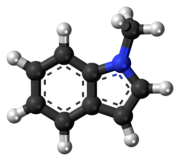|
1-Methylindole
1-Methylindole
![]()
|

|
| Names
|
| Preferred IUPAC name
|
| Identifiers
|
|
|
|
|
|
|
| ChEMBL
|
|
| ChemSpider
|
|
| ECHA InfoCard
|
100.009.143 
|
| EC Number
|
|
|
|
|
| UNII
|
|
|
|
|
InChI=1S/C9H9N/c1-10-7-6-8-4-2-3-5-9(8)10/h2-7H,1H3  Y YKey: BLRHMMGNCXNXJL-UHFFFAOYSA-N  Y YInChI=1/C9H9N/c1-10-7-6-8-4-2-3-5-9(8)10/h2-7H,1H3 Key: BLRHMMGNCXNXJL-UHFFFAOYAN
|
c1cccc2c1ccn2C Cn1ccc2c1cccc2
|
| Properties
|
|
|
C9H9N
|
| Molar mass
|
131.177
|
| Boiling point
|
236 to 239 °C (457 to 462 °F; 509 to 512 K)
|
| Hazards
|
| GHS labelling:
|
|
|

|
|
|
Warning
|
|
|
H302, H312, H315, H319, H332, H335
|
|
|
P261, P264, P270, P271, P280, P301+P312, P302+P352, P304+P312, P304+P340, P305+P351+P338, P312, P321, P322, P330, P332+P313, P337+P313, P362, P363, P403+P233, P405, P501
|
| Safety data sheet (SDS)
|
External MSDS from Oxford University
|
Except where otherwise noted, data are given for materials in their standard state (at 25 °C [77 °F], 100 kPa). |
Chemical compound
1-Methylindole is an irritating, potentially toxic organic compound which occurs as a deep yellow viscous liquid with a very strong unpleasant odor.[1]
It has the chemical formula C9H9N.
See also
References
|
|